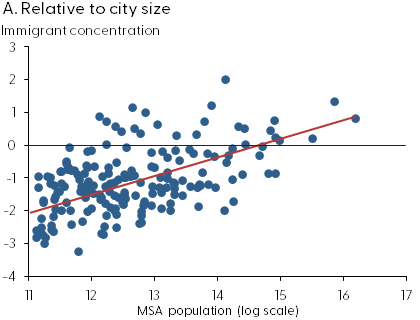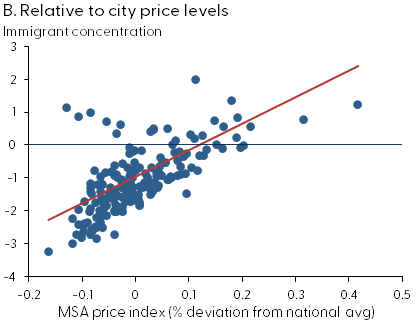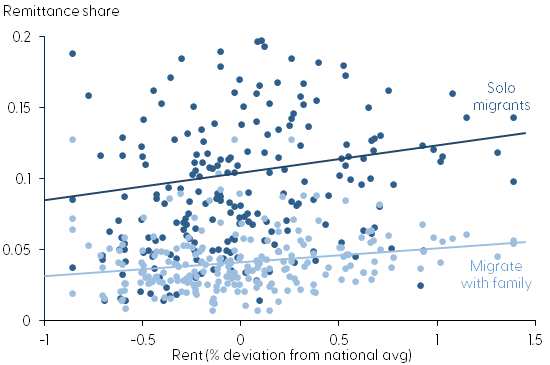Immigration is fundamentally an urban phenomenon. Both in the United States and elsewhere, immigrants settle primarily in cities—especially high-wage, high cost-of-living cities. The most likely reason is that immigrants often send a significant share of their income back to their origin country. As a result, they value a city’s high wages and are less discouraged by the high living costs than native-born workers. Migration policies can reinforce this urban concentration pattern.
The share of immigrants in the population of the United States and many other developed countries is at its highest level since at least the early 1900s. The total number of immigrants living in the United States started to rise in the late 1970s and expanded rapidly through the early 2000s. Since then, the share of immigrants—measured as the foreign-born population divided by the total population—has stabilized at almost 20%. Immigration inflows have remained high through most of the 21st century, but return migration has also been high, generally balancing the total numbers. The trend reversed during the COVID pandemic, when immigration to the United States fell precipitously, although it has recovered somewhat since then (Duzhak 2023).
Much of the policy debate surrounding immigration focuses on its impact on economic activity, particularly on its labor market impact for workers born in the host country. Less emphasis has been put on how immigration is shaping the structure of the economy. In this Economic Letter, I argue that an important and often overlooked aspect of immigration is its urban nature. Immigrants, both in the United States and elsewhere, settle primarily in the largest and most expensive cities. Hence, the potential benefits of immigration accrue most prominently to these select cities. However, immigration also includes potential costs that are felt by existing workers who compete for jobs in those cities or who would like to move to select cities but are deterred from doing so due to tougher competition for jobs, housing, and other local goods. I also present similar evidence for China, where much of this urban immigration phenomenon is due to policies that discourage family migration relative to individual worker migration.
Immigrants concentrate in select cities
A striking feature related to immigration is the degree to which immigrants disproportionately settle in select cities that are large and expensive. One way to measure this is to compute the number of immigrants in each city relative to the total number of immigrants in the population and compare that to the same calculation for native-born residents, referred to here as the “immigrant concentration.” While many definitions of geographic data would work for this calculation, for city-specific data I use metropolitan statistical areas (MSAs) from the 2000 U.S. census.
Figure 1, panel A shows a strong positive relationship between immigrant concentration and city size, as indicated by the upward slope of the red fitted line. Moreover, there is a relatively small number of cities where the immigrant concentration is greater than the national average, which is indicated by the black horizontal line at zero. These two facts mean that immigrants tend to be concentrated in a small number of select cities and that those cities tend to be large. Those large cities also tend to be expensive, as measured in panel B by the MSA price index, which, to a large extent, reflects housing prices. The data points in panel B follow the red fitted line more closely than the points in panel A, which reflects that city price levels are more associated with city size for immigrant concentration.
Figure 1
Concentration of immigrant population in U.S. cities


Source: Census Bureau (2000)
Note: Each dot represents a metropolitan statistical area (MSA). Concentration is defined as the number of immigrants in a city relative to all immigrants in the economy, divided by the same number computed for native-born workers. The horizontal lines at zero mark the national average for immigrant concentration
At first, this relationship may seem puzzling. Why would immigrants concentrate so much in places where it is very expensive to live? A possible explanation could be that immigrants put pressure on housing markets. Perhaps immigrants choose to live in large housing units in destination cities and hence disproportionately increase the demand for housing. Another explanation could be that immigrants are drawn to cities with high demand for labor, and that high demand for labor also leads to high housing costs. A final explanation could be that new immigrants follow existing immigrant networks, and those happen to exist only in select cities.
However, evidence from recent research points toward different explanations. As Albert and Monras (2022) and Monras (2020) document in detail, immigrants tend to consume much less housing and put less pressure on housing markets than native-born residents with equivalent characteristics. Research also shows that demand for labor is unlikely to be a key factor. For example, the data show no systematic relationship between city size and wages after taking into account the local cost of living. The large amount of research that studies how workers spread out across cities (see, for example, Glaeser 2008) assumes that individuals are compensated for high housing costs and thus end up indifferent between high- and low-cost cities. By contrast, Albert and Monras (2022) argue that the concentration of immigrants in these high-wage and expensive cities is driven primarily by their choice of location, as opposed to the overall strength of these cities’ labor markets.
The main hypothesis in Albert and Monras (2022) is simple. A large share of immigrants keeps ties with their origin countries. Many send money, known as remittances, to family members in those countries, while others plan to eventually return to their birthplace. In either case, this means that a substantial part of immigrants’ spending, now or in the future, takes place in their origin country rather than in the city where they currently work. Hence, for immigrants, the local prices in the city where they work only matter for the fraction of their total budget spent there. This means, that, relative to native-born workers, immigrants are equally attracted to high wages in select cities but less deterred by high local prices—particularly housing. This simple mechanism can explain why immigrants concentrate so much in a small number of select cities, and why these cities tend to have the highest costs of living.
Evidence from China
This fact has important implications for migration policies around the world. One main reason immigrants may want to reserve part of their income for use in their country of origin is because family members often stay behind. These immigrants’ patterns are also evident for internal migration within large countries. A striking example comes from the surge in rural to urban migration China experienced in the early 2000s. Many rural workers left the countryside to find jobs in the booming manufacturing industries located in the coastal cities. By many accounts, this was the largest migration in history, numbering in the hundreds of millions.
This large migration episode in China was governed by the Hukou policy. Among its main features, the policy stated that, while rural workers were free to move within China, they were required to keep their rural Hukou registration at their origin. This meant that rural workers migrating to cities did not have access to many local public services, most prominently public health care and education, in their destination city. Hence, this migration policy imposed high costs for rural workers who migrated with family members, for instance children and the elderly. As a consequence, many migrants moved to the city while their family stayed behind. This, in turn, meant that remittances were a key aspect of the rural to urban migration experience in China, as is also true for international immigrants in the United States.
Using newly assembled Chinese data, Imbert et al. (2023) have documented that rural migrants in China also settle primarily in a few select, high-cost cities. Moreover, the Chinese data allow the authors to document in more detail migrants’ spending patterns, something that is harder to do for international migrants in the United States. With these data, they show how migrants who decided to leave their family members behind tended to live in worse housing conditions in their destination cities and tended to place a higher value on remittances. For instance, based on their study, the share of income remitted is more than double among solo migrants than among people who bring their family when migrating. Figure 2 represents those shares for each Chinese city and how they change in relation to the local cost of living, measured by the average rent prices in each city, as shown by the linear fitted lines in the graph.
Figure 2
Remittances for migrants with or without families: China

Source: Imbert et al. (2023), based on China Migrants Dynamic Survey data.
Note: Data show the average income remitted (vertical axis) against a measure of the local cost of living for migrants who leave the family behind and for migrants who migrate with their close family members (children and elder parents). Each dot represents the average by migrant type within Chinese prefectures.
This evidence suggests that migration policy is likely to have a strong influence on whether immigrants view their experience as a means to increase their family’s income and potentially investment (see Khanna et al. 2022) at their origin location, rather than as a move to a new permanent location with greater opportunities for upward socioeconomic mobility.
From the viewpoint of destination communities and countries, migration policy influences the spatial distribution of economic activity and the type of migration. In particular, migration policies that increase the cost of family migration relative to individual worker migration also increase the degree to which immigrants primarily settle in a relatively small number of select cities. In other words, policies that encourage immigrants to bring family members with them will likely lead immigrants to settle in a broader set of destinations across a country. Furthermore, these types of policies may lead to more income staying in the domestic economy rather than being sent back to workers’ origin countries.
Conclusion
In this Economic Letter, I explain why immigration is fundamentally an urban phenomenon. Using Chinese data, I also show how this pattern interacts with family migration policies. Higher costs of immigrating with family members leads to a more concentrated immigrant population in select cities and also lowers incentives for immigrants to consume and invest at the destination.
Whether a high concentration of immigrants in select cities has positive or negative economic effects depends, to some extent, on the economic characteristics of those cities. On the one hand, if select cities are disproportionately productive or have labor shortages, such concentrations could be economically beneficial by bringing in additional workers. On the other hand, it may be valuable for the economy as a whole, and potentially to areas outside of those select cities in particular, to encourage immigrants to spread more evenly across the territory. Understanding these tradeoffs may be useful for designing immigration and internal migration policies in various countries, particularly as they relate to family members.
Joan Monras, Research Advisor, Economic Research Department, Federal Reserve Bank of San Francisco
References
Albert, Christoph, and Joan Monras. 2022. “Immigration and Spatial Equilibrium: The Role of Expenditures in the Country of Origin.” American Economic Review 112(11, November), pp. 3,763–3,802.
Duzhak, Evgeniya. 2023. “The Role of Immigration in U.S. Labor Market Tightness.” FRBSF Economic Letter 2023-06 (February 27).
Glaeser, Edward. 2008. Cities, Agglomeration and Spatial Equilibrium. Oxford: Oxford University Press.
Imbert, Clément, Joan Monras, Marlon Seror, and Yanos Zylberberg. 2023. “Floating Population: Migration with(out) Family and the Spatial Distribution of Economic Activity.” Work in progress.
Khanna, Gaurav, Emir Murathanoglu, Caroline B. Theoharides, and Dean Yang. 2022. “Abundance from Abroad: Migrant Income and Long-Run Economic Development.” National Bureau of Economic Research Working Paper 29862.
Monras, Joan. 2020. “Immigration and Wage Dynamics: Evidence from the Mexican Peso Crisis.” Journal of Political Economy 128(8, August), pp. 3,017–3,089.
Opinions expressed in FRBSF Economic Letter do not necessarily reflect the views of the management of the Federal Reserve Bank of San Francisco or of the Board of Governors of the Federal Reserve System. This publication is edited by Anita Todd and Karen Barnes. Permission to reprint portions of articles or whole articles must be obtained in writing. Please send editorial comments and requests for reprint permission to research.library@sf.frb.org